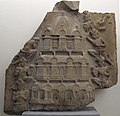Buddhist temple
India
The design of temples in India was influenced by the idea of a place of worship as a representation of the universe. For Buddhist temple complexes one tall temple is often centrally located and surrounded by smaller temples and walls. This is symbolic of Buddhist imagining of the universe with Mount Meru at the center surrounded by oceans, lesser mountains and a huge wall.[3]
A Chaitya, Chaitya hall or Chaitya-griha refers to a shrine, sanctuary, temple or prayer hall in Indian religions. The term is most common in Buddhism, where it refers to a space with a stupa and a rounded apse at the end opposite the entrance, and a high roof with a rounded profile. Strictly speaking, the chaitya is the stupa itself, and the Indian buildings are chaitya halls, but this distinction is often not observed. Many of the early Chaitya were rock-cut, as in Karla caves or Ajanta.

Some of the earliest free-standing temples may have been of a circular type. Ashoka also built the Mahabodhi Temple in Bodh Gaya circa 250 BCE, a circular structure, in order to protect the Bodhi tree under which the Buddha had found enlightenment. The Bairat Temple is also a round structure, which can be seen through archaeological remains. Representations of this early temple structure are found on a 100 BCE relief sculpted on the railing of the stupa at Bhārhut, as well as in Sanchi.[4] From that period the Diamond throne remains, an almost intact slab of sandstone decorated with reliefs, which Ashoka had established at the foot of the Bodhi tree.[5][6] These circular-type temples were also found in later rock-hewn caves such as Tulja Caves or Guntupalli.[7]
Ashoka's Mahabodhi Temple and Diamond throne in Bodh Gaya, built circa 250 BCE. Bharhut frieze.
Bodhi tree temple depicted in Sanchi, Stupa 1, Southern gateway.
Relief of a multi-storied temple, 2nd century CE, Ghantasala Stupa.[8][9]
Remains of the circular rock-hewn circular Chaitya with columns, Tulja Caves
.Japanese Buddhism
Japanese Buddhist temples typically include a Main Hall.
A distinctive feature is the chinjusha, a Shinto shrine devoted to the temple's kami. Buddhism co-existed with shintoism, but in the 8th century Buddhism became the state religion and Buddhist temples were built.








Comments
Post a Comment